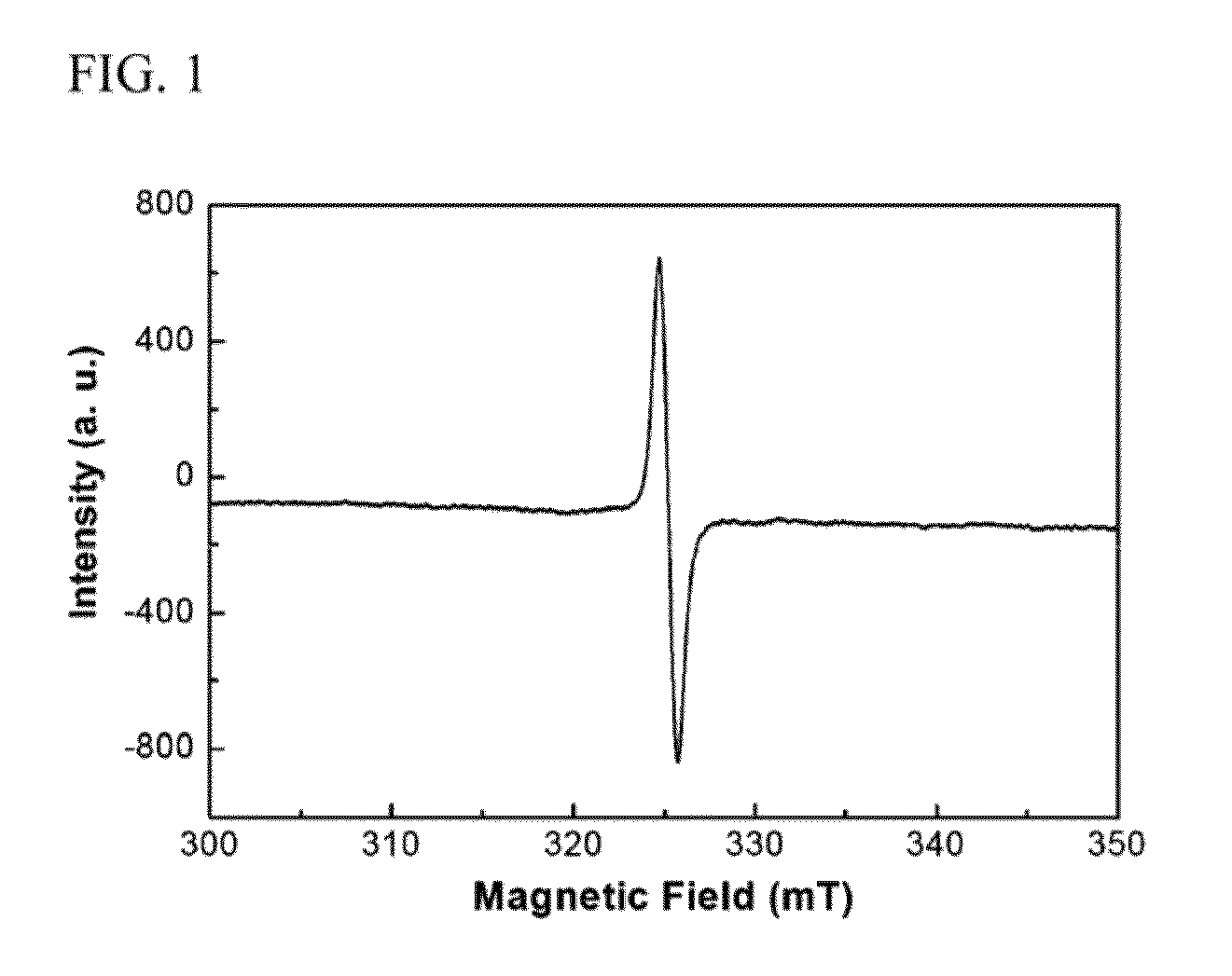Organic radical polyimide electrode active material, and electrochemical device comprising same
a polyimide electrode and active material technology, applied in the direction of li-accumulators, non-aqueous electrolyte accumulator electrodes, cell components, etc., can solve the problems of difficult to ensure the lifespan of secondary batteries, difficult to increase the degree of curing, and difficult to apply it to next-generation batteries such as flexible ultrathin batteries. achieve stable oxidation-reduction reaction, high energy density, and high radical density
- Summary
- Abstract
- Description
- Claims
- Application Information
AI Technical Summary
Benefits of technology
Problems solved by technology
Method used
Image
Examples
preparation example 1
Synthesis of Center Block Material
[0066]
[0067]In order to substitute oxygen (O) of diaminoanthraquinone (DAQ) with sulfur (S), DAQ and Lawesson's reagent were put into a flask, and then a reaction was conducted at 110° C. for 24 hours to obtain a first reaction product. Subsequently, an aromatic mixed solvent, a catalyst and the first reaction product were put into a three-neck flask, and then a reaction started at 100° C. At an early stage of the reaction, the reaction mixture was red and opaque, but became dark with the passage of time. After several hours had passed since the reaction, the reaction mixture changed into a clear brown reaction product solution. After the reaction had finished, the reaction product solution became very dark and was partially precipitated as soon as the temperature decreased to room temperature. After the reaction was finished, the reaction product solution stabilised at room temperature was shifted to another flask, and was then separated and purifi...
preparation example 2
Synthesis of TDAQ
[0069]
[0070]The obtained S-substituted DAQ was reacted with 4-Oxo-TEMPO and a catalyst (P(OEt)3) at 110° C. for 24 hours to obtain TDAQ. First, center block and side block were dissolved in DMSO to prepare a solution, a catalyst was added to the solution, and then the solution was stirred to be uniformly dispersed. The uniformly-dispersed solution was heated to 120° C. and then reacted for about 24 hours. At the end of the reaction, the color of the solution had become dark compared to the color thereof at an early stage of the reaction. Therefore, it was ascertained that the center block had bonded with a side block.
[0071]The reaction product solution including the bonded center block and side block was separated and purified using column chromatography. The purified reaction product solution was slowly heated, and simultaneously evaporated using a rotary evaporator to remove a solvent therefrom, thus obtaining a solid reaction product. Subsequently, the solid reac...
preparation example 3
Synthesis of PMDA-TDAQ Polyamic Acid
[0075]
[0076]PMDA-TDAQ PAA, which is a solvent-soluble polyamic acid, was synthesized by reacting TDAQ and PMDA at low temperature (0° C.) for 72 hours without using a catalyst. After the reaction was finished, a solution was precipitated by non-solvent to obtain solid matter, and then the solid matter was dried. Specifically, first, TDAQ was put into a three-neck flask, and was then completely dissolved in a mixed solvent to prepare a mixed solution. Subsequently, a soluble comonomer and a catalyst were added to the mixed solution, and then the mixed solution was stirred until it became uniform. Then, the uniformly stirred mixed solution was reacted for about 72 hours while the temperature was controlled. The color of the mixed solution at an early stage of the reaction was clear light brown, but gradually changed to dark brown with the passage of time, and this color was maintained until the reaction was finished. After the reaction had finished,...
PUM
| Property | Measurement | Unit |
|---|---|---|
| wavelength | aaaaa | aaaaa |
| magnetic field | aaaaa | aaaaa |
| temperature | aaaaa | aaaaa |
Abstract
Description
Claims
Application Information
 Login to View More
Login to View More - R&D
- Intellectual Property
- Life Sciences
- Materials
- Tech Scout
- Unparalleled Data Quality
- Higher Quality Content
- 60% Fewer Hallucinations
Browse by: Latest US Patents, China's latest patents, Technical Efficacy Thesaurus, Application Domain, Technology Topic, Popular Technical Reports.
© 2025 PatSnap. All rights reserved.Legal|Privacy policy|Modern Slavery Act Transparency Statement|Sitemap|About US| Contact US: help@patsnap.com



